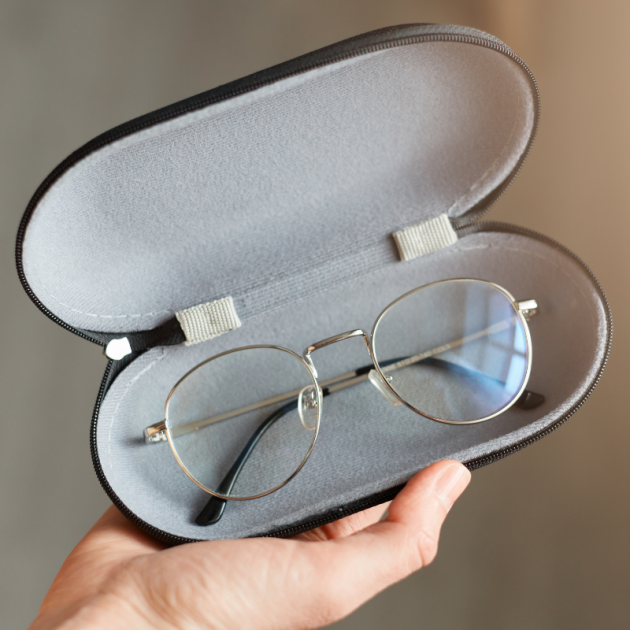
Astigmatism is a common refractive error — when the shape of your eye prevents light from focusing correctly on your retina. It’s a common cause of blurry vision but, thankfully, can be diagnosed and treated with the use of corrective lenses. Read on to learn more about astigmatism and how it can be corrected.
What is astigmatism?
Astigmatism happens when your eyes aren’t completely round. Usually, eyeballs are round and shaped like footballs. Astigmatism happens when the shape of your eye looks more rugby ball-shaped. This can either happen gradually over time or is something you can be born with.

It’s a very common refractive error. The irregular shape of your eye means that light entering your eye doesn’t focus correctly on your retina which can cause blurry vision, distorted images, and starburst effects when looking at bright lights.
Types of astigmatism
Regular astigmatism
A healthy eye has a spherical cornea or lens, meaning the curves around the entire eye are the same. An eye with astigmatism, however, has a steep curve and a flat curve, also known as the two principal meridians.
Regular astigmatism happens when the two principal meridians are 90 degrees apart, with one meridian steeper than the other. This type of astigmatism is the most common type and can be corrected by glasses, contact lenses, or laser surgery.
Regular astigmatism can also be described as either “with-the-rule” or “against-the-rule” depending on which way the steepest angles of your eye face. With-the-rule astigmatism means your eye is shaped like a rugby ball lying on the ground with the steepest curves running vertically and is most common in younger people. Against-the-rule astigmatism means your cornea is shaped like a rugby ball on its end with the steepest curves running horizontally and is more common in older adults.

Irregular astigmatism
Where regular astigmatism occurs when the two principal medians are always at right angles, irregular astigmatism happens when the two principal medians are not symmetrical. The curvature of your cornea is uneven. This type of astigmatism is harder to correct than regular astigmatism.
Irregular astigmatism is usually caused by disease such as keratoconus (gradual thinning of the cornea), corneal degeneration, corneal scarring, or ocular surface disease.
Astigmatism combined with refractive errors
You can also have astigmatism combined with other refractive errors. In a normal eye, the meridians work together to focus light into a single point on the retina. When you have astigmatism, the eye cannot focus light on a single point and instead creates two focal points. Combine that with other refractive errors like myopia – nearsightedness or hyperopia – farsightedness, and it’s likely that you’ll need corrective measures like glasses, contact lenses, or laser eye surgery.
Simple Myopic: The combination of astigmatism and nearsightedness in which one focal point comes before the retina, while the other is on the retina.
Compound Myopic: A combination of astigmatism and nearsightedness in which both focal points fall before the retina.
Mixed: The combination of astigmatism, nearsightedness and farsightedness in which one focal point is before the retina and the other focal point is behind the retina.
Simple Hyperopic: A combination of astigmatism and farsightedness in which one focal point is on the retina while the other is behind the retina.
Compound Hyperopic: A combination of astigmatism and farsightedness in which both focal points are behind the retina.
Causes of astigmatism
We know that astigmatism is caused by a cornea or lens that has a different shape than normal. It can be inherited – it may be present from birth or develop later in life – or it may develop after an eye injury, disease or surgery. Astigmatism isn't caused or made worse by reading in poor light, sitting too close to the television or squinting.

Diagnosing astigmatism
Astigmatism is diagnosed through comprehensive eye exams. A complete eye exam such as Leightons’ Ultimate Eye Exam involves a series of tests to check eye health and refraction – which determines how the eyes bend light.
Your optometrist may use various instruments, aim bright lights directly at your eyes and ask you to look through several lenses to examine different aspects of your eyes and vision, and to determine the prescription needed to provide clear vision with glasses or contact lenses.
Treatment options
There are multiple options available for helping to correct astigmatism.
Glasses: one of the most common ways to fix astigmatism. They contain a cylindrical lens that compensates for the uneven curves in your cornea or lens. People with severe astigmatism may be better suited for glasses instead of contacts. This is often one of the most cost-effective options although wearing glasses can be inconvenient depending on your lifestyle.
Contact lenses: offer similar benefits of glasses but sit directly on your eye. Whether you are offered soft or hard contact lenses will depend on your prescription and severity of astigmatism so it’s worth speaking to your optician about your options. Contact lenses are another cost-effective option but aren’t available for very severe prescriptions and aren’t ideal for those who don’t like touching their eyes.
Refractive surgery: A surgery procedure that helps to improve vision and reduces the need for glasses or contact lenses. Your eye surgeon will use a laser beam to reshape the curves of the cornea, which corrects the refractive error and can be very effective for many people. Surgery can be expensive as it’s not typically offered on the NHS and comes with more complications than other methods of treatment. However the effects can be permanent and may be more suited to those with more severe vision problems.
There is no one “right” way to correct astigmatism. You should choose the method that works best for your prescription, your lifestyle, and your comfort levels. Speak to your optometrist and optician to help find the best solution for you.
Managing astigmatism
If you’ve been diagnosed with astigmatism, it’s, thankfully, easy to manage from here on.

Make sure you are scheduling regular eye exams to keep an eye on the condition and catch any changes in your vision early. You can book your eye tests through Leighton’s directly.
Ensure you are taking proper care of your glasses – storing them in a scratch proof case when not in use and cleaning them regularly – and understand the importance of safe contact lens use to reduce the risk of introducing bacteria to your eye.
Eye-healthy lifestyle habits can also help manage your symptoms including eating a nutritionally balanced diet and avoiding eye strain – making changes to your screen usage where possible, reading in well lit areas, and ensuring you take regular breaks.
Conclusion
Astigmatism is a very common vision problem but is one that can be easily and effectively corrected through a variety of different treatment options. If you suspect you might have astigmatism, or have experienced a change in your vision, reach out to your local eye care professional to determine the best treatment approach for your needs.








